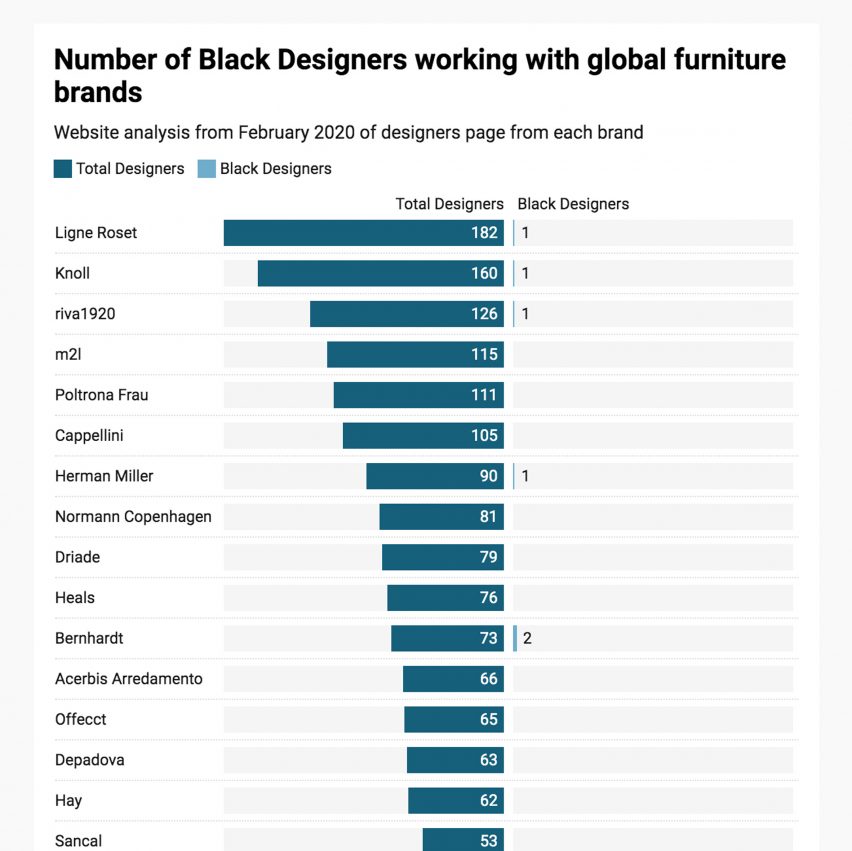
Just 0.32 per cent of the furniture produced by leading brands is created by black designers, according to research by Ethiopian American industrial designer Jomo Tariku.
Tariku made the calculation by recording the designer of each collection from 150 of the world's leading furniture brands listed on the Swiss products site Architonic over the past year.
The Virginia-based designer told Dezeen that he was not surprised by the finding.
"We are not represented in the design world"
"My research put numbers to what most black designers have been saying; that we are not represented in the design world," said Tariku.
First reported in home design magazine Business of Home, his research looked at 4,417 branded collections. Of these, only 14 were collaborations with black designers, equating to 0.32 per cent. Tariki's research can be found here.

"My discovery was specific to furniture as I am a furniture designer," added Tariki, who previously worked as a data scientist for the World Bank Group. "Others have said the same thing about fashion, architecture and even in graphic design."
He prepared the data as part of a presentation entitled Black design: History, theory & practice, which was presented at Princeton's African American studies graduate seminar, after noticing that the design industry was much less diverse than his previous profession – data visualisation.
The trend has barely changed in the past 20 years"
"I have been attending furniture shows for a while and consistently noticed that there were very few black designers and that trend has barely changed in the past 20 years of me intermittently attending shows including in Europe and the Middle East," he explained.
Tariku used Architonic's database as the basis for counting the number of collaborations between brands and designer.
In his workings, some designers will have been counted multiple times as they collaborate several times with the same brand or with multiple different brands.
The majority of the brands that Tariku focused on had not collaborated with a single black designer, while well-known brands like Knoll had collaborated with only one black designer in 160 collaborations and Herman Miller only one black designer in 90 collaborations.
Tariku describes his research is a "decent sample" of the furniture design industry and hopes that the quantitative evidence he has collected will clearly demonstrate design's lack of diversity.
"Numbers like these are hard to argue against"
"Numbers like these are hard to argue against, especially after the industry promised to do better," he said. "Whether impactful change will be realized remains to be seen."
"I plan to revisit these numbers and I hope researchers and journalists will do their own analysis. I conducted this research on my own in order to tell our story from a different angle and have a robust conversation," he continued.
"Our Eurocentric design vocabulary needs to expand"
Tariku believes that while the industry needs to listen to many voices as it reflects on how to improve its diversity, it needs to look beyond traditional European design aesthetics to broaden
"I, for example, keep hearing – and I agree – that our Eurocentric design vocabulary needs to expand and reach into the global south," he said. "You can read Vitra's "Atlas of Furniture Design" and towards the end, the author talks about this point."
"The global south includes countries in Africa, Latin America and other countries South of the Equator. I say challenge the owners of these cultures to be involved in design work instead of wholly appropriating concepts that originate from there in the name of doing something new or different," he continued.
"I also believe one's own culture plays a big role in one's design philosophy while trying to address a market need. I feel that is a missing piece of the puzzle at this moment. Other designers of Color might give you their own reason."
Tariku's quantitive research echoes the lack of diversity that many have experienced in the design industry. Speaking to Dezeen as part of Virtual Design Festival, New York-based Stephen Burks explained how he was always the first black designer that brands had worked with.
"As you know, international design isn't the most diverse place," he told Dezeen. "It's been my great privilege to be the first and only African American to work with all my clients. And that's kind of crazy. You realise that design is kind of this final frontier of culture."
The post Black designers responsible for less than one third of one per cent of leading furniture designs appeared first on Dezeen.
https://ift.tt/2CjVwRR
twitter.com/3novicesindia
No comments:
Post a Comment